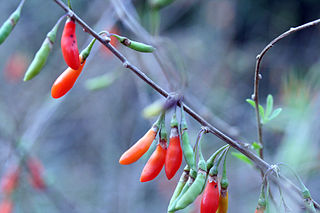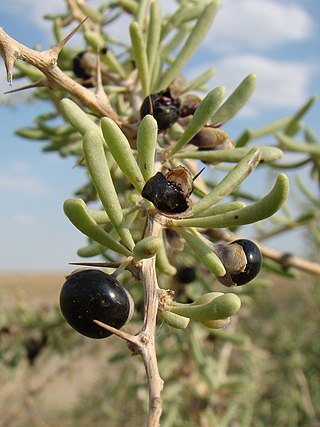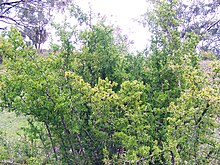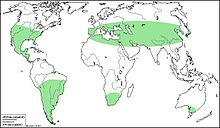
Goji, goji berry, or wolfberry is the sweet fruit of either Lycium barbarum or Lycium chinense, two closely related species of boxthorn in the nightshade family, Solanaceae. L. barbarum and L. chinense fruits are similar but can be distinguished by differences in taste and sugar content.

Physalis is a genus of approximately 75 to 90 flowering plants in the nightshade family (Solanaceae), which are native to the Americas and Australasia. At least 46 species are endemic to Mexico. Cultivated and weedy species have been introduced worldwide. A defining feature of Physalis is a large, papery husk derived from the calyx, which partly or fully encloses the fruit. Many species bear edible fruit, and some species are cultivated.

Lycium barbarum is a shrub native to China, with present-day range across Asia and southeast Europe. It is one of two species of boxthorn in the family Solanaceae from which the goji berry or wolfberry is harvested, the other being Lycium chinense.

Lycium chinense is one of two species of boxthorn shrub in the family Solanaceae. Along with Lycium barbarum, it produces the goji berry ("wolfberry"). Two varieties are recognized, L. chinense var. chinense and L. chinense var. potaninii. It is also known as Chinese boxthorn, Chinese matrimony-vine, Chinese teaplant, Chinese wolfberry, wolfberry, and Chinese desert-thorn.
Goji refers to the fruit of Lycium barbarum and Lycium chinense, two very closely related species of boxthorn in the family Solanaceae.
Christmasberry can refer to any one of several shrubs or small trees, as well as their colorful fruit:

Lycium californicum is a spreading shrub in the nightshade family known by the common names California boxthorn and California desert-thorn.

Lycium andersonii is a species of flowering plant in the nightshade family, Solanaceae. Its common names include water-jacket, redberry desert-thorn, Anderson thornbush, Anderson's desert thorn, Anderson boxthorn, Anderson lycium, Anderson wolfberry, and squawberry.

Lycium ferocissimum, the African boxthorn or boxthorn, is a shrub in the nightshade family (Solanaceae) indigenous to South Africa.

Iochroma arborescens is a species of flowering plant in the genus Iochroma, belonging to the nightshade family Solanaceae. Formerly it was considered the single species in the monotypic genus Acnistus. Common names include gallinero, mata-gallina, fruta-de-sabiá, hollowheart, wild tobacco, siyou, bastard sirio, galán arbóreo, tabaco de monte, nigüito, marieneira, güitite, and tabak djab.
Coleophora ningxiana is a moth of the family Coleophoridae which is endemic to China (Ningxia).

Lycium ruthenicum, is a flowering plant commonly known as Russian box thorn in the West. is a species of flowering plant in the nightshade family which can be found in Central Asia, southern part of Russia, throughout Northwest China, Northern India and Pakistan. Also commonly known as black fruit wolfberry, siyah goji, and kaokee.

Lycium afrum, the kraal honey thorn is a shrub in the potato family (Solanaceae), indigenous to the Western Cape Province, South Africa.

The Solanaceae, or the nightshades, are a family of flowering plants that ranges from annual and perennial herbs to vines, lianas, epiphytes, shrubs, and trees, and includes a number of agricultural crops, medicinal plants, spices, weeds, and ornamentals. Many members of the family contain potent alkaloids, and some are highly toxic, but many—including tomatoes, potatoes, eggplant, bell and chili peppers—are used as food. The family belongs to the order Solanales, in the asterid group and class Magnoliopsida (dicotyledons). The Solanaceae consists of about 98 genera and some 2,700 species, with a great diversity of habitats, morphology and ecology.

Lycium australe, the Australian boxthorn, is a native Australian plant with large sharp woody spines, small leaves and very small berries. It is closely related to Lycium ferocissimum, which is listed as an invasive weed in Australia, New Zealand and Cyprus.

Lycium europaeum, the European tea tree, European box‑thorn, or European matrimony‑vine, is a species of flowering plant in the family Solanaceae. It is native to the entire Mediterranean region, and has been introduced to the Canary Islands, Madeira, and the Balearic Islands. Its fruit is edible.
Lycium ferocissimum, the African boxthorn, is a species of shrub in the family Solanaceae (nightshades). They have a self-supporting growth form. Individuals can grow to 1.5 m.
Lycium pumilum is a shrub in the nightshade family (Solanaceae) indigenous to South Africa and Namibia.
Lycium cinereum is a shrub in the nightshade family (Solanaceae) indigenous to southern Africa. It is widespread across South Africa, as well as southern Namibia and Botswana.

















